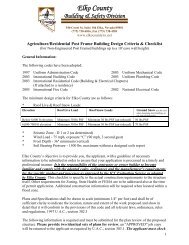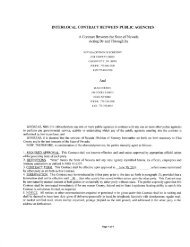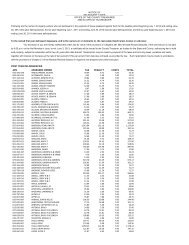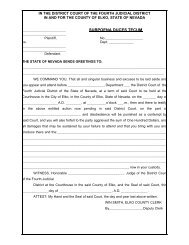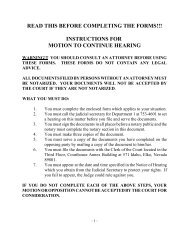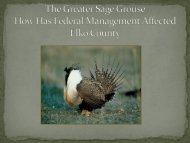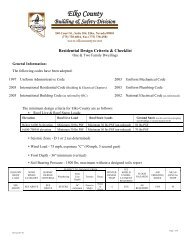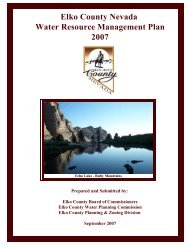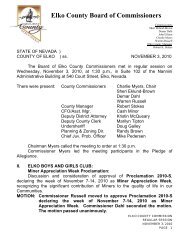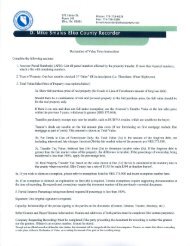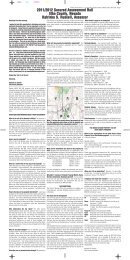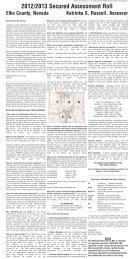Spring Creek/Lamoille - Elko County
Spring Creek/Lamoille - Elko County
Spring Creek/Lamoille - Elko County
You also want an ePaper? Increase the reach of your titles
YUMPU automatically turns print PDFs into web optimized ePapers that Google loves.
According to the Soils Conservation Service rating system, a “Severe” rating is given to soils that have<br />
one or more properties unfavorable for the rated use. These properties include, steep slopes, bedrock<br />
near the surface, flood zones, high shrink or swell potential, a seasonal high water table, or low strength.<br />
This degree of limitation generally requires major soil reclamation, special design, or intensive<br />
maintenance.<br />
When ratings are made by the Soil Conservation Service in relation to septic tank absorption fields, only<br />
the soil between the depths of 24 and 60 inches are considered. Consideration is given to the affect of<br />
soil limitations and site features on the absorption of the effluent, construction and maintenance of the<br />
system, and public health.<br />
Limitations and site features that affect the absorption of the effluent are permeability, depth of seasonal<br />
high water, depth to bedrock, cemented pan, and a susceptibility to flooding. Stones, boulders, and a<br />
shallow depth to bedrock or a cemented pan interfere with the installation. Excessive slope may cause<br />
lateral seepage and surfacing of effluent in down slope areas. Erosion is also a hazard where absorption<br />
fields are installed in sloping soils.<br />
Percolation tests used to evaluate soil suitability for septic absorption fields should be performed during<br />
the seasons when the water table is at its highest and the soil is at minimum absorptive capacity.<br />
Experience indicates that soils that have a percolation rate of faster than 45 minutes per inch function<br />
satisfactorily, soils that have a rate of 45 to 60 minutes per inch have moderate limitations, and soils that<br />
have a rate slower than 60 minutes per inch have severe limitations.<br />
Drainage and Flood Plains<br />
Drainage within the <strong>Spring</strong> <strong>Creek</strong> / <strong>Lamoille</strong> Master Plan area is collected by Ten Mile <strong>Creek</strong>, Mitchell<br />
<strong>Creek</strong>, Rabbit <strong>Creek</strong>, and <strong>Lamoille</strong> <strong>Creek</strong>. All of which except Ten Mile <strong>Creek</strong> flow directly into the<br />
Humboldt River. Ten Mile <strong>Creek</strong> flows to the South Fork of the Humboldt River.<br />
Approximately 2,000 acres along these drainage collectors have been identified by the Federal<br />
Emergency Management Agency (FEMA) as being flood prone and have been designated on the official<br />
flood maps of that agency as "Areas of Special Flood Hazards".<br />
As set forth in Title 44 of the Code of Federal Regulations, the Federal Emergency Management Agency<br />
(FEMA) administers the National Flood insurance Program. This program provides a means of making<br />
flood insurance available to owners of property that has been identified as being prone to flooding.<br />
In order for the flood insurance to be available, the community in which the property identified as flood<br />
prone is located must participate in the program. <strong>Elko</strong> <strong>County</strong> does actively participate in the FEMA<br />
program. All building permit and zoning applications are reviewed for flood plain location.<br />
One of the stipulations that Federal Emergency Management Agency (FEMA) places on a participating<br />
community is the promotion of better flood plain management through ordinances and building codes<br />
that meet certain criteria as set forth by federal regulations. The purpose of the National Flood<br />
Insurance Program is to carry out national goals of minimizing the loss of lives, property, and natural<br />
resources due to flooding.<br />
Pg. 13



